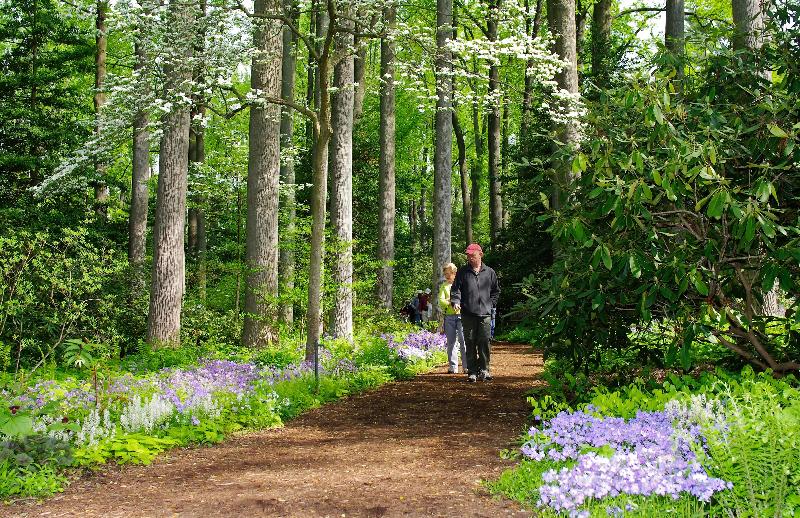April 19 to November 9, 2013
No reservations required to see the gardens on Fridays and Saturdays
This spring, Mt. Cuba Center, one of America's most distinguished native plant gardens, will be more accessible than ever. From April 19th through November 9th, 2013, the gardens will be open on Fridays and Saturdays from 10am to 4pm. Visitors are encouraged to explore the scenic ponds or take a restful seat in the Formal Garden, participate in learning activities or enjoy a brief specialized tour. No reservations are required and tickets may be purchased onsite the day of a visit. Open Day tickets are $6 for adults, $4 for ages 6-16, and free for children 5 and under. The former home of Mr. and Mrs. Lammot du Pont Copeland located in the rolling hills of the Brandywine Valley outside Wilmington, Delaware, Mt. Cuba Center focuses on native plants of the eastern United States through displays, research and education programs. The scenic woodland gardens are the featured point of interest in the nearly 600 acres of natural lands dedicated to the conservation of rare and endangered plants in a managed open space.
The Visitor Experience
The emphasis on native materials begins at the entrance sign, crafted from Barley Mill gneiss, a rock found only in this area, and surrounded by native plants that were chosen for their strong visual appeal to both garden visitors and drive-by traffic. The hand-forged steel gate created by a local artist, Greg Leavitt, incorporates some of Mrs. Copeland's favorite native plants - trilliums, magnolias and ferns, a hint of what is to come. Bordering the main drive are Rock and Scree gardens, whose foundations were created when the indigenous rock formation was blasted to create a driveway to the main house. The garden showcases drought and heat-tolerant plants from the Appalachian Piedmont.
At the end of the ½-mile drive is the administrative and educational headquarters of Mt. Cuba Center, a Colonial Revival-style house, completed in 1937. Guided garden tours and education classes begin at this stately building. Open Day visitors are greeted in the Guest Parking lot where tickets may be purchased. From any starting point, the next stop is the native plant gardens that are uniquely Mt. Cuba Center's own.
The Gardens of Mt. Cuba Center
On the scenic terrace, plantings of espaliered southern magnolias, mature American hollies and flashy native azaleas bloom in the heat of summer. Allees of sweet gums and oaks add structure to this garden by leading visitors down a leafy corridor to the kinetic statue "Samara turning with the Wind" by local artist Andre Harvey.
Designed by prominent landscape architects Thomas Sears and Marian Coffin, the Formal Garden features seasonal displays of color-themed annuals, native perennial and showy native shrubs in concentric circles. The annuals are picked to best show the color combinations found at the Maltese cross-shaped pool area.
Leaving the formal area, visitors may enter the Trial Garden. Here, tickseeds, coral bells and Baptisia as well as other native species are tested for their performance in a variety of conditions. Over a 3-year trial period, the goal is to determine which species and cultivars survive best in mid-Atlantic conditions: hot, humid summers and unpredictable winters and to share that research with the nursery industry. Visitors are encouraged to vote for their favorites. Data from this garden is collected, tabulated for publication and found under the Horticultural Research section of Mt. Cuba Center's website: www.mtcubacenter.org/horticultural-research/trial-garden-research/.
From the sunny trial area, the coolness of the woods beckons. The giant tulip poplars draw one's gaze upwards, a sight that Mrs. Copeland wished to share -- "I want visitors to look up as well as look down." Visitors experience this naturalistic garden as so uncontrived as to appear that the plants and trees grew here of their own accord. Trilliums, false rue-anemone and bloodroot blanket the ground in spring, creating tapestries of floral displays. Flowering azaleas, hydrangea, and buckeye compliment the understory through the summer. Autumn brings brilliant color change to the leaves of hickory, tupelo, and oaks from green to brilliant crimsons, yellows, and auburns. Winding paths disappear in the distance - beckoning garden visitors to travel further down the hill.

At the bottom of a long downhill stroll are the Pond Gardens. This woodland area includes a series of four man-made ponds connected by rills and spillways. Lowland plants such oaks, birches and magnolias make their home here along with other plants that require "wet feet" for sun or shade. In the bog garden are many pitcher plants and even native orchids. Visitors may rest in the 19th-century gazebo and listen for the sounds that water and nature bring together.
The Meadow at Mt. Cuba Center showcases native plants of open sunny areas and woods edges of the Piedmont. Paths through the middle of this sunny grassland wander past beautiful, fragrant flowering plants. Native grasses such as little bluestem, broom sedge, and yellow Indian grass dominate the Meadow and become the canvas for a constantly changing collection of beautiful wildflowers from late spring until frost.
Evening Access to the Gardens
In addition to regular Open Day hours - 10AM to 4PM on Fridays and Saturdays - Friday hours will be extended to 7pm from May 3 to July 26. Visitors are encouraged to relax and rejuvenate in the cooler evening air, bring a meal and dine in the new outdoor picnic area.




Comments